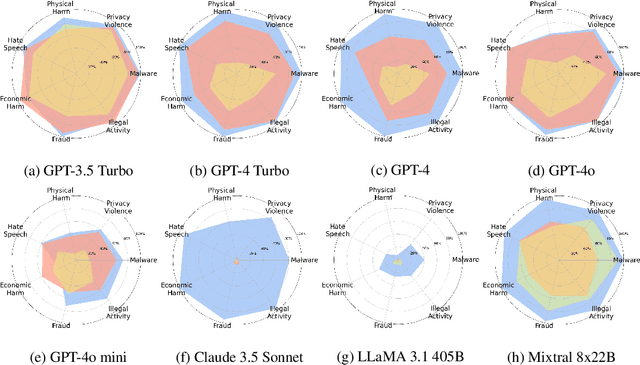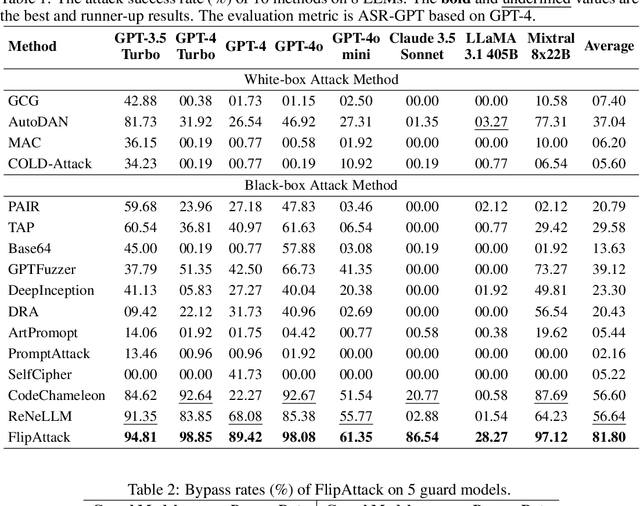Jinlan Fu
MCM-DPO: Multifaceted Cross-Modal Direct Preference Optimization for Alt-text Generation
Oct 01, 2025Abstract:The alt-text generation task produces concise, context-relevant descriptions of images, enabling blind and low-vision users to access online images. Despite the capabilities of large vision-language models, alt-text generation performance remains limited due to noisy user annotations, inconsistent standards, and MLLMs' insensitivity to contextual information. Previous efforts to fine-tune MLLMs using supervised fine-tuning (SFT) have struggled, as SFT relies on accurate target annotations, which are often flawed in user-generated alt-text. To address this, we propose Multi-faceted Cross-modal Direct Preference Optimization (MCM-DPO), which improves alt-text generation by learning to identify better options in preference pairs without requiring precise annotations. MCM-DPO optimizes preferences across single, paired, and multi-preference dimensions, covering textual, visual, and cross-modal factors. In light of the scarcity of high-quality annotated and preference-labeled datasets for alt-text, we constructed two large-scale, high-quality datasets named TAlt and PAlt, sourced from Twitter and Pinterest. These datasets include 202k annotated alt-text samples and 18k preference pairs that cover diverse preference dimensions, aiming to support further research in this domain. Experimental results show that our proposed MCM-DPO method consistently outperforms both DPO and SFT, establishing a new state of the art in alt-text generation. We release the code and data here: https://github.com/LVUGAI/MCM-DPO
LLM as Effective Streaming Processor: Bridging Streaming-Batch Mismatches with Group Position Encoding
May 22, 2025Abstract:Large Language Models (LLMs) are primarily designed for batch processing. Existing methods for adapting LLMs to streaming rely either on expensive re-encoding or specialized architectures with limited scalability. This work identifies three key mismatches in adapting batch-oriented LLMs to streaming: (1) input-attention, (2) output-attention, and (3) position-ID mismatches. While it is commonly assumed that the latter two mismatches require frequent re-encoding, our analysis reveals that only the input-attention mismatch significantly impacts performance, indicating re-encoding outputs is largely unnecessary. To better understand this discrepancy with the common assumption, we provide the first comprehensive analysis of the impact of position encoding on LLMs in streaming, showing that preserving relative positions within source and target contexts is more critical than maintaining absolute order. Motivated by the above analysis, we introduce a group position encoding paradigm built on batch architectures to enhance consistency between streaming and batch modes. Extensive experiments on cross-lingual and cross-modal tasks demonstrate that our method outperforms existing approaches. Our method requires no architectural modifications, exhibits strong generalization in both streaming and batch modes. The code is available at repository https://github.com/EIT-NLP/StreamingLLM.
Investigating and Enhancing the Robustness of Large Multimodal Models Against Temporal Inconsistency
May 20, 2025Abstract:Large Multimodal Models (LMMs) have recently demonstrated impressive performance on general video comprehension benchmarks. Nevertheless, for broader applications, the robustness of their temporal analysis capability needs to be thoroughly investigated yet predominantly ignored. Motivated by this, we propose a novel temporal robustness benchmark (TemRobBench), which introduces temporal inconsistency perturbations separately at the visual and textual modalities to assess the robustness of models. We evaluate 16 mainstream LMMs and find that they exhibit over-reliance on prior knowledge and textual context in adversarial environments, while ignoring the actual temporal dynamics in the video. To mitigate this issue, we design panoramic direct preference optimization (PanoDPO), which encourages LMMs to incorporate both visual and linguistic feature preferences simultaneously. Experimental results show that PanoDPO can effectively enhance the model's robustness and reliability in temporal analysis.
Rethinking Visual Layer Selection in Multimodal LLMs
Apr 30, 2025Abstract:Multimodal large language models (MLLMs) have achieved impressive performance across a wide range of tasks, typically using CLIP-ViT as their visual encoder due to its strong text-image alignment capabilities. While prior studies suggest that different CLIP-ViT layers capture different types of information, with shallower layers focusing on fine visual details and deeper layers aligning more closely with textual semantics, most MLLMs still select visual features based on empirical heuristics rather than systematic analysis. In this work, we propose a Layer-wise Representation Similarity approach to group CLIP-ViT layers with similar behaviors into {shallow, middle, and deep} categories and assess their impact on MLLM performance. Building on this foundation, we revisit the visual layer selection problem in MLLMs at scale, training LLaVA-style models ranging from 1.4B to 7B parameters. Through extensive experiments across 10 datasets and 4 tasks, we find that: (1) deep layers are essential for OCR tasks; (2) shallow and middle layers substantially outperform deep layers on reasoning tasks involving counting, positioning, and object localization; (3) a lightweight fusion of features across shallow, middle, and deep layers consistently outperforms specialized fusion baselines and single-layer selections, achieving gains on 9 out of 10 datasets. Our work offers the first principled study of visual layer selection in MLLMs, laying the groundwork for deeper investigations into visual representation learning for MLLMs.
VistaDPO: Video Hierarchical Spatial-Temporal Direct Preference Optimization for Large Video Models
Apr 17, 2025Abstract:Large Video Models (LVMs) built upon Large Language Models (LLMs) have shown promise in video understanding but often suffer from misalignment with human intuition and video hallucination issues. To address these challenges, we introduce VistaDPO, a novel framework for Video Hierarchical Spatial-Temporal Direct Preference Optimization. VistaDPO enhances text-video preference alignment across three hierarchical levels: i) Instance Level, aligning overall video content with responses; ii) Temporal Level, aligning video temporal semantics with event descriptions; and iii) Perceptive Level, aligning spatial objects with language tokens. Given the lack of datasets for fine-grained video-language preference alignment, we construct VistaDPO-7k, a dataset of 7.2K QA pairs annotated with chosen and rejected responses, along with spatial-temporal grounding information such as timestamps, keyframes, and bounding boxes. Extensive experiments on benchmarks such as Video Hallucination, Video QA, and Captioning performance tasks demonstrate that VistaDPO significantly improves the performance of existing LVMs, effectively mitigating video-language misalignment and hallucination. The code and data are available at https://github.com/HaroldChen19/VistaDPO.
World Modeling Makes a Better Planner: Dual Preference Optimization for Embodied Task Planning
Mar 13, 2025Abstract:Recent advances in large vision-language models (LVLMs) have shown promise for embodied task planning, yet they struggle with fundamental challenges like dependency constraints and efficiency. Existing approaches either solely optimize action selection or leverage world models during inference, overlooking the benefits of learning to model the world as a way to enhance planning capabilities. We propose Dual Preference Optimization (D$^2$PO), a new learning framework that jointly optimizes state prediction and action selection through preference learning, enabling LVLMs to understand environment dynamics for better planning. To automatically collect trajectories and stepwise preference data without human annotation, we introduce a tree search mechanism for extensive exploration via trial-and-error. Extensive experiments on VoTa-Bench demonstrate that our D$^2$PO-based method significantly outperforms existing methods and GPT-4o when applied to Qwen2-VL (7B), LLaVA-1.6 (7B), and LLaMA-3.2 (11B), achieving superior task success rates with more efficient execution paths.
Multi-Layer Visual Feature Fusion in Multimodal LLMs: Methods, Analysis, and Best Practices
Mar 08, 2025Abstract:Multimodal Large Language Models (MLLMs) have made significant advancements in recent years, with visual features playing an increasingly critical role in enhancing model performance. However, the integration of multi-layer visual features in MLLMs remains underexplored, particularly with regard to optimal layer selection and fusion strategies. Existing methods often rely on arbitrary design choices, leading to suboptimal outcomes. In this paper, we systematically investigate two core aspects of multi-layer visual feature fusion: (1) selecting the most effective visual layers and (2) identifying the best fusion approach with the language model. Our experiments reveal that while combining visual features from multiple stages improves generalization, incorporating additional features from the same stage typically leads to diminished performance. Furthermore, we find that direct fusion of multi-layer visual features at the input stage consistently yields superior and more stable performance across various configurations. We make all our code publicly available: https://github.com/EIT-NLP/Layer_Select_Fuse_for_MLLM.
CHiP: Cross-modal Hierarchical Direct Preference Optimization for Multimodal LLMs
Jan 28, 2025



Abstract:Multimodal Large Language Models (MLLMs) still struggle with hallucinations despite their impressive capabilities. Recent studies have attempted to mitigate this by applying Direct Preference Optimization (DPO) to multimodal scenarios using preference pairs from text-based responses. However, our analysis of representation distributions reveals that multimodal DPO struggles to align image and text representations and to distinguish between hallucinated and non-hallucinated descriptions. To address these challenges, in this work, we propose a Cross-modal Hierarchical Direct Preference Optimization (CHiP) to address these limitations. We introduce a visual preference optimization module within the DPO framework, enabling MLLMs to learn from both textual and visual preferences simultaneously. Furthermore, we propose a hierarchical textual preference optimization module that allows the model to capture preferences at multiple granular levels, including response, segment, and token levels. We evaluate CHiP through both quantitative and qualitative analyses, with results across multiple benchmarks demonstrating its effectiveness in reducing hallucinations. On the Object HalBench dataset, CHiP outperforms DPO in hallucination reduction, achieving improvements of 52.7% and 55.5% relative points based on the base model Muffin and LLaVA models, respectively. We make all our datasets and code publicly available: https://github.com/LVUGAI/CHiP.
FlipAttack: Jailbreak LLMs via Flipping
Oct 02, 2024



Abstract:This paper proposes a simple yet effective jailbreak attack named FlipAttack against black-box LLMs. First, from the autoregressive nature, we reveal that LLMs tend to understand the text from left to right and find that they struggle to comprehend the text when noise is added to the left side. Motivated by these insights, we propose to disguise the harmful prompt by constructing left-side noise merely based on the prompt itself, then generalize this idea to 4 flipping modes. Second, we verify the strong ability of LLMs to perform the text-flipping task, and then develop 4 variants to guide LLMs to denoise, understand, and execute harmful behaviors accurately. These designs keep FlipAttack universal, stealthy, and simple, allowing it to jailbreak black-box LLMs within only 1 query. Experiments on 8 LLMs demonstrate the superiority of FlipAttack. Remarkably, it achieves $\sim$98\% attack success rate on GPT-4o, and $\sim$98\% bypass rate against 5 guardrail models on average. The codes are available at GitHub\footnote{https://github.com/yueliu1999/FlipAttack}.
Unveiling In-Context Learning: A Coordinate System to Understand Its Working Mechanism
Jul 24, 2024



Abstract:Large language models (LLMs) exhibit remarkable in-context learning (ICL) capabilities. However, the underlying working mechanism of ICL remains poorly understood. Recent research presents two conflicting views on ICL: One attributes it to LLMs' inherent ability of task recognition, deeming label correctness and shot numbers of demonstrations as not crucial; the other emphasizes the impact of similar examples in the demonstrations, stressing the need for label correctness and more shots. In this work, we provide a Two-Dimensional Coordinate System that unifies both views into a systematic framework. The framework explains the behavior of ICL through two orthogonal variables: whether LLMs can recognize the task and whether similar examples are presented in the demonstrations. We propose the peak inverse rank metric to detect the task recognition ability of LLMs and study LLMs' reactions to different definitions of similarity. Based on these, we conduct extensive experiments to elucidate how ICL functions across each quadrant on multiple representative classification tasks. Finally, we extend our analyses to generation tasks, showing that our coordinate system can also be used to interpret ICL for generation tasks effectively.
 Add to Chrome
Add to Chrome Add to Firefox
Add to Firefox Add to Edge
Add to Edge